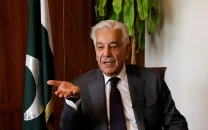Film-screening review: ‘Roti’ depicts plight of the oppressed caused by greed
Mehboob Khan's classic film 'Roti', produced in 1942, was screened at SAFMA Media Centre.

Film-screening review: ‘Roti’ depicts plight of the oppressed caused by greed
A private screening of Mehboob Khan’s classic film Roti was held at SAFMA Media Centre the other day. The film was produced in 1942, the year in which World War II ended. It is truly representative of the director’s craftsmanship in his early work.
His first film, Judgment of Allah, was made in 1935. In those days, Khan typically concentrated on the plight of the oppressed classes, focusing on the life and culture of rural India. Besides many other laurels to his credit, he was later best known for directing Mother India in 1957, which won the Film Fare awards for best film and best director and was nominated for the Academy Award for best foreign language film.
The film starts with reeking scenes of poverty-stricken people running after one loaf of bread. The main story revolves around an imposter Laxmi Das, performed by Chandarmohan, who poses as the son of a wealthy and widowed owner of a garments factory.
The greed of Das is contrasted with the primitive communism of a remote tribe, whose chief Balam (Sheikh Mukhtar) ensures that the produce of the fields is equally distributed among the entire tribe. The tribe despises gold which, according to them, is the chief source of all social evils. Das uses every trick and tactic to amass wealth. He becomes trapped in vicious circles which ultimately ruins him. The two female characters, one played by Akhtaribai Faizabadi as Darling in the film and the other by Sitara Devi as Kinari are personifications of love and other good traits.
The film is continually interspersed with a strange Machiavellian character named Jaggu who preaches violence and tyranny in order to snatch roti (bread) from the affluent. He gleefully taunts the poor, blaming them for their own lack of courage and initiative.
Most of his discourse is through song.
The story writer Chaudhary, was perhaps continuing the tradition of Munshi Prem Chand, whose short stories and novels depict class consciousness and struggle. In Indian cinema, Mehboob Khan, Khawaja Ahmed Abbas and Zia Sarhadi were ideologically committed to following the messages imprinted on their minds after 1917’s October Revolution in Russia. Many films were produced on these lines, such as Hum Log, Footpath, Do Bhega Zamin and Boot Polish.
The film’s lead performer, Chandra Mohan, was a
great actor who also played major roles in Humayun
and Pukar.
It was good to see Begum Akhter play the role of Darling, which she performed brilliantly. Anil Biswas, one of the great composers, who was also affiliated with the Communist Party of India, was the film’s music director. Who can forget his evergreen melodies Kismat, Tarana and Abhimaan?
Published in The Express Tribune, March 21st, 2011.



















COMMENTS
Comments are moderated and generally will be posted if they are on-topic and not abusive.
For more information, please see our Comments FAQ